- Details
- Hits: 4975
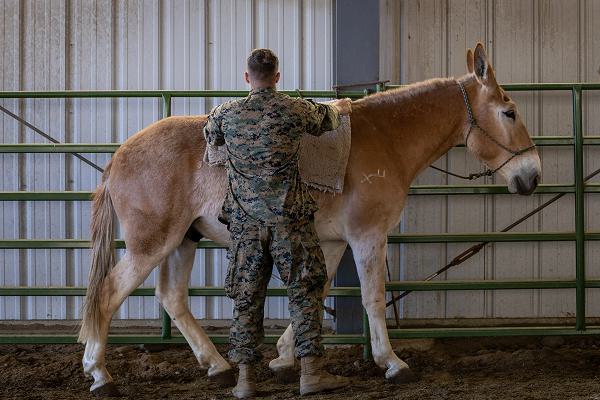
Bridgeport, California. (June 20, 2024): For over two hundred years, America has relied on the dependable mule to serve as “beasts of burden” and they continue to play an important military role today. In this photo by Lance Corporal David Intriago, Corporal Parker Shaffer loads equipment onto a pack mule during Mountain Training Exercise 4-24 at Marine Corps Mountain Warfare Training Center here. The exercise familiarizes Marines with the many uses of these loyal animals when operating at high altitude and in mountainous terrain.
The faithful Mule, a hybrid of a horse and donkey, was first used by the U.S. military by General George Crook. Known to history as America’s best Indian fighter, General Crook saw donkeys as a solution to the difficulty of using wagons to cross mountains and streams. Wagons would often bog down in mud, flip over when crossing streams, or could not handle steep mountainous terrain. General Crook found that four or six mules could carry the same as a wagon and be able to negotiate virtually any terrain. Later during the Civil War, mules were used to pull supply wagons, artillery equipment, ambulances, and food supplies.
- Details
- Hits: 1061
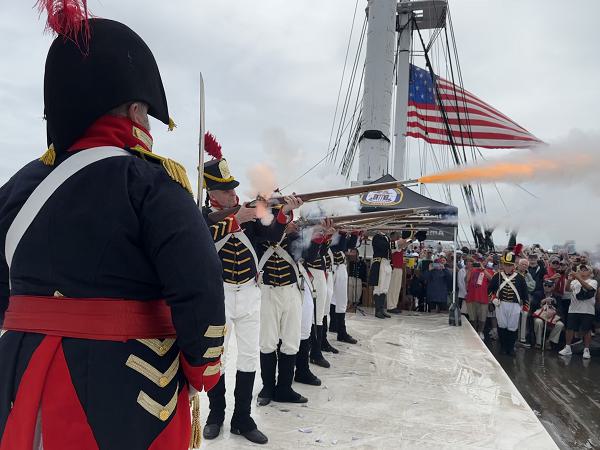
Boston, Massachusetts. (July 2, 2024): In this photo by MC1 Raymond Minami, volunteers with the 812 Marine Guard fire a saluting volley aboard USS Constitution during 4th of July celebrations in Boston Harbor. The world's oldest commissioned warship, the USS Constitution was launched in 1797 after President George Washington ordered the creation of an American Navy. She earned the nickname “Old Ironsides” after cannonballs seemed to bounce off her hull in a battle against the British warship HMS Guerriere. She also played a key role during the Barbary Wars (1801-1805) defending American shipping lanes against pirates. She was undefeated in battle, destroyed or captured 33 opponents, and is credited as the only remaining U.S. Navy ship to have sunk an enemy warship.
Today, the 227-year-old vessel is a floating museum and a training venue for a select few lucky Sailors who get to live in a piece of history. During numerous patriotic celebrations throughout the year, the USS Constitution will fire its cannons in a 21-gun salute while Sailors, dressed in traditional garb, weigh anchor and man the ship’s sails just as they did at the beginning of the Republic. Each year, over 600,000 civilians are given free tours of the ship and her operations as part of the Navy’s mission to preserve our maritime heritage.
The USS Constitution’s role as a training facility for young officers (midshipmen) began in 1860 when she sailed to Annapolis, Maryland to serve the U.S. Naval Academy. Today, midshipmen perform “climbing revolutions”, scrambling up and down the rigging and sails of this ancient vessel, as they learn modern navigation and leadership. These crews also assist the Constitution’s Museum staff as they host thousands of school groups from across the country.
- Details
- Hits: 1347
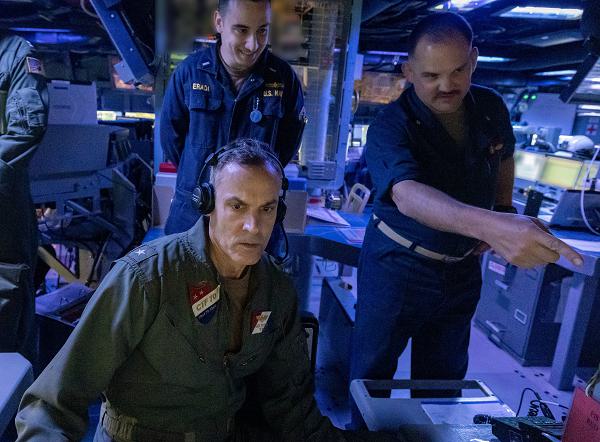
Philippine Sea. (June 11, 2024): They are responsible for the lives of thousands of Sailors and billions in military hardware, and serve on the front lines in a dangerous world. Meet Rear Admiral Greg Newkirk, pictured left, commander of Task Force 70 and Carrier Strike Group 5, and Commander Stephen Szachta, commanding officer of the Arleigh Burke-class guided-missile destroyer USS Rafael Peralta at work in the combat information center (Photo by MC1 Devin Monroe).
The commanders are guiding their respective forces during Exercise Valiant Shield 24, a multinational operation to demonstrate the world’s resolve to uphold freedom of navigation in the Indo-Pacific. The timing of these drills comes at a fraught moment for America’s allies in the region. Last week, Chinese and Philippine forces clashed once again in the South China Sea resulting in numerous injuries and raising the danger of the U.S. intervention. Under the existing 1951 U.S-Philippine Mutual Defense Treaty, Article V states that “one partner is obliged to come to the other’s aid in the event of an armed attack”.
China has asserted sovereignty over nearly all the South China Sea, including islands falling within Philippine’s exclusive economic zone. The international courts dismissed these claims in 2016 but Beijing has ignored these rulings and continues to threaten and harass peaceful shipping. In the latest incident, Chinese naval forces used non-deadly force, including water cannons, up-close maneuvers that risk a collision, and alleged high-powered laser and sonic devices against Filipino vessels.
This is where the American Navy comes in. Rising to meet these provocations are the Sailors of the USS Ronald Reagan Carrier Strike Group.
- Details
- Hits: 2934
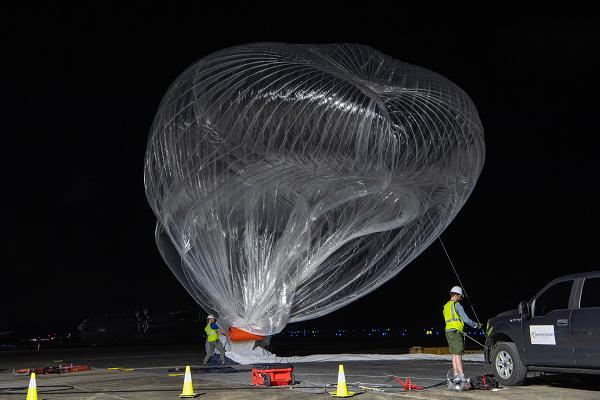
Antonio B. Won Pat International Airport, Guam. (June 10, 2024): With the recent shoot down of a Chinese spy balloon, many Americans are asking if we still use balloons in our Air Force. In this photo by Senior Airman Natalie Doan, Flight operations personnel prepare to launch a high-altitude balloon in support of Exercise Valiant Shield 2024. The U.S. military continues to use balloons of all types for long endurance, persistent air capabilities that serve as platforms for a variety of payloads and sensors.
The first recorded use of balloons for military purposes was in China during the Han Dynasty in 202 BC. The Chinese used lanterns for military communications including paper-made hot air balloons to signal a call for rescue. During the American Civil War, the Union Army established the Balloon Corps which employed “aeronauts” flying gas-filled balloons to spy on the Confederate Army. During World War II, the Navy used balloon airships in anti-submarine warfare in the Mediterranean.
Balloons also have a long history of espionage. As early as 1850, the American military established the Corps of Topographical Engineers for mapmaking and observation of enemy troops. When tethered to the ground, these “kites” provided a stable platform to gain a bird’s eye view of troop positions and movements on the battlefield.
Balloons and kites were the first inventions used in aerial warfare and their primary role was reconnaissance. Later, incendiary devices were added to light fires or drop explosives on enemy positions.
- Details
- Hits: 1174
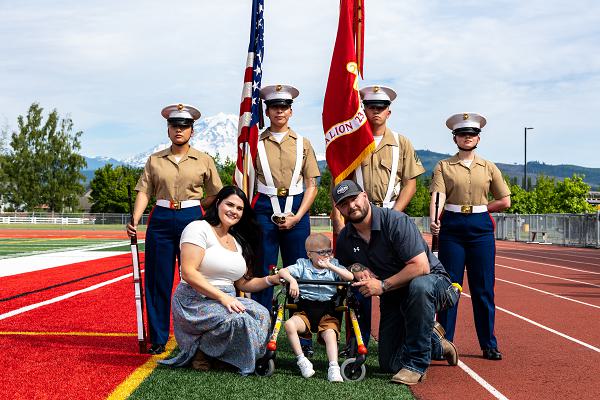
Orting, Washington. (June 8, 2024): The U.S. Marines have extended “honorary” status to its youngest recipient, a four-year-old boy battling bravely against cancer. In this photo by Staff Sergeant Courtney White, Arlan Russell, accompanied by this parents Josh, a Marine Corps veteran, and mom Carrie, pose for a photograph with a Marine Corps color guard at the conclusion of his Honorary Marine ceremony here. The title of “Honorary Marine” is bestowed by the Commandant of the Marine Corps to civilians who have made extraordinary contributions to the Marines.
According to Staff Sergeant Courtney White, little Arlan was born with a Mitochondrial disease that affects his heart, liver, brain, muscles, and bones. He was not expected to live past his first year, but his condition improved over time due to medication and IV therapy. Unfortunately, in 2023, his condition worsened, and doctors found inoperable tumors on his liver. There is no safe treatment for his liver cancer, making his illness terminal.
- Details
- Hits: 883
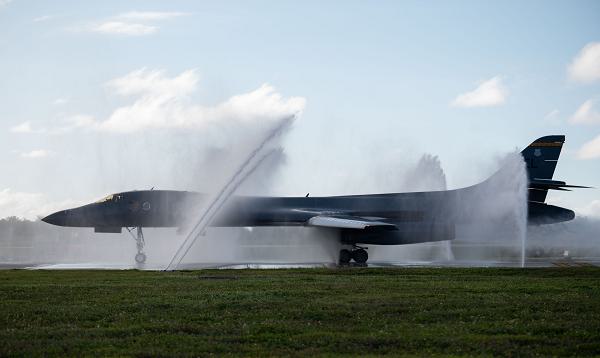
Andersen Air Force Base, Guam. (June 13, 2024): In this photo by Airman 1st Class Audree Campbell, a B-1B Lancer from the 37th Expeditionary Bomb Squadron receives a bath after returning from a practice mission. The Lancer dates to President Ronald Reagan in 1988 and has been the backbone of America’s long range bomber force ever since. It can rapidly deliver massive quantities of precision and non-precision weapons against any adversary, anywhere in the world, at any time.
A key feature of the Lancer is its swept wings which are set forward on takeoff and sweep back for supersonic flight. These wings give the B1-B incredible maneuverability and greater speeds, particularly at high altitudes. In addition to carrying a substantial payload, the Lancer has advanced radar targeting systems and the ability to “loiter” over an area for a substantial period. Using mid-air refueling, the Lancer can strike targets day or night and in all weather.
The Lancer has a synthetic aperture radar that is capable of tracking, targeting, and engaging moving vehicles and an extremely accurate Global Positioning System-aided Inertial Navigation System allowing aircrews to navigate without the aid of ground-based radars.
For self-defense, the B1-B carries electronic jamming equipment including a radar warning receiver and countermeasures like chaff or flares. These systems identify the full spectrum of threatening emissions and apply the appropriate jamming technique automatically.


